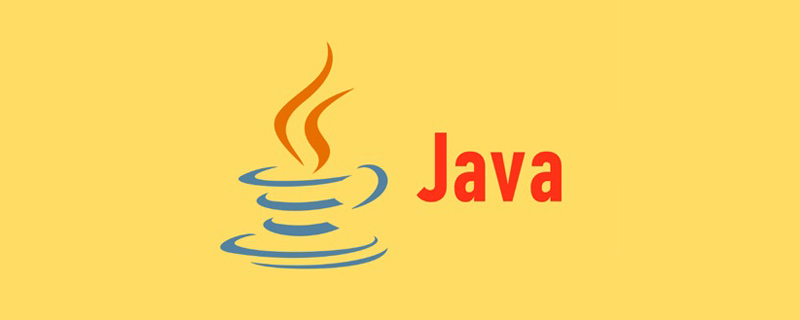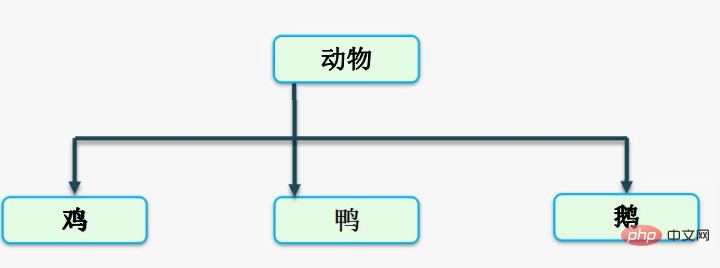What are the three major features of java?
Java's three major characteristics: 1. Encapsulation, which refers to hiding the properties and implementation details of an object and only providing public access to the outside; 2. Inheritance, deriving new classes from existing classes, new Classes can absorb the data attributes and behaviors of existing classes, and can expand new capabilities; 3. Polymorphism, a method can have multiple implementation versions, that is, "one definition, multiple implementations."

Related recommendations: "Java Video Tutorial"
The three major characteristics of Java are considered unique to Java Performance, when it comes to the three major features of Java, we will all think of encapsulation, inheritance and polymorphism, which are the most important features of our Java.
Encapsulation:
Encapsulation: refers to hiding the properties and implementation details of an object and only providing public access to the outside world.
Benefits:
Isolate changes.
Easy to use.
Improve reusability.
Improve security.
Encapsulation principle:
Hide content that does not need to be provided to the outside world.
Hide all properties and provide public methods to access them.
private keyword:
is a permission modifier.
Used to modify members (member variables and member functions)
Privated members are only valid in this class.
One of the commonly used ones:
Private member variables and provide corresponding set and get methods to access them. Improved security of access to data.
Give a chestnut:
The blood loss model we often talk about
public class Demo {
private String name;
private String sex ;
private int age;
public String getName() {
return name;
}
public void setName(String name) {
this.name = name;
}
public String getSex() {
return sex;
}
public void setSex(String sex) {
this.sex = sex;
}
public int getAge() {
return age;
}
public void setAge(int age) {
this.age = age;
}
}Construction code block and construction method (Construct):
Construction method:
is used to initialize the object and the corresponding object. It has Targeted, one of the functions.
Features:
- The name of the function is the same as the name of the class.
- No need to define the return value type.
- This function has no specific return value.
- The constructor is not called manually by us (manual calling refers to such as b1.baby();), but when the corresponding object is created, the JVM will actively call it to the corresponding constructor.
- If a class does not explicitly write a constructor, the Java compiler will add a parameterless constructor to the class.
- If a class has explicitly written a constructor, the Java compiler will not add a parameterless constructor to the class.
- Multiple constructors can exist in a class in the form of function overloading.
- Constructor methods include parameterless constructor and parameterized constructor. The JVM creates a parameterless constructor by default. If a parameterized constructor is manually created, the system will recognize the parameterized constructor by default.
构造函数的定义格式:
修饰符 函数名(形式参数){
函数体;
}
修饰符 函数名(){
函数体;}The difference between constructor method and ordinary method:
(1) The difference between return value type:
①Construction Functions have no return value type. If void or other return value types are added, it becomes an ordinary function, which requires us to call it manually.
② Ordinary functions have a return value type. Even if the function does not return a value, the return value type must be written void.
(2) The difference between function names:
① The function name of the constructor must be consistent with the class name.
②The function name of an ordinary function only needs to comply with the naming rules of identifiers.
(3) Differences in calling methods:
① The constructor is called by the JVM when creating an object.
② Ordinary functions are called by us using objects. An object can call ordinary functions multiple times.
(4) Differences in function:
①The function of the constructor is to initialize an object. Every object created has an initial value.
② Ordinary functions are used to describe the public behavior of a class of things.
Notes:
(1) The permission modifier of the parameterless constructor added by the Java compiler is consistent with the permission modifier of the class.
(2) The constructor is called when creating an object, so you can pass the attribute value to the constructor, and set the parameters in the constructor to receive the attribute value.
(3)JVM和Java编译器是不同的,Java编译器编译生成的.class文件是给JVM看的,所以经过编译后的class类打开后会是乱码,我们可以通过反编译来查看。
构造代码块:
1.构造代码块的作用与构造函数的作用的对比:
(1)构造代码块的作用:给所有对象进行统一的初始化,对象一建立就运行并且优先于构造函数,比如所有的婴儿出生都会哭。
(2)构造函数的作用:给对应的对象(new )进行初始化。
构造代码块的格式:
{
构造代码块;
}
注意:构造代码块的大括号必须位于成员的位置上。代码块的类别:
(1)构造代码块:在工作中经常会用到。
(2)局部代码块:大括号位于方法之内,基本上写不写没什么区别,现实开发中也很少会用到。它的作用是缩短局部变量的生命周期,节省一点点内存。
(3)静态代码块:使用static修饰的代码块。
注意的事项:
(1)Java编译器在编译一个Java源文件的时候,会把成员变量的声明语句提前至一个类的最前端。
(2)成员变量的初始化工作其实都是在构造函数中执行的。
(3)一旦经过Java编译器编译后,那么构造代码块的代码就会被移动到构造函数中执行,构造代码块的代码是在构造函数之前执行的,构造函数中的代码是最后执行的。
(4)成员变量的显示初始化与构造代码块的代码是按照当前代码的顺序执行的。
继承(inheritance):
继承是面向对象最显著的一个特性。 继承是从已有的类中派生出新的类, 新的类能吸收已有类的数据属性和行为,并能扩展新的能力。
在JAVA中, 被继承的类叫父类(parent class)或超类(superclass), 继承父类的类叫子类(subclass)或派生类(derivedclass)。 因此, 子类是父类的一个专门用途的版本, 它继承了父类中定义的所有实例变量和方法, 并且增加了独特的元素 。
继承的结构:

继承的使用 :
关键字:extends。
使用继承
– 编写父类
– 编写子类, 继承父类
class Animal {
//公共的属性和方法
}
class Chicken extends Animal{
//子类特有的属性和方法
}
class Duck extends Animal {
}基本语法:
class Chicken extends Animal{ } 上述代码表示Chicken类继承Animal类,使用extends关键词将Animal类(父类/超类)和Chicken类(子类)连接接起来;
在继承关系下,Chicken类将拥有Animal类所有的非私有的方法和属性,Chicken类还可以拥有自己独有的方法和属性;
声明Animal类,实例化Chicken类时, Chicken类会自动向上转型为Animal类;
举个栗子:
//创建动物类
public class Animal {
private String type;
private String skin;
private int legCount;
public void eat(){
System.out.println("动物正在吃东西");
}
public void breath(){
System.out.println("动物正在呼吸");
}
public String getType() {
return type;
}
public void setType(String type) {
this.type = type;
}
public String getSkin() {
return skin;
}
public void setSkin(String skin) {
this.skin = skin;
}
public int getLegCount() {
return legCount;
}
public void setLegCount(int legCount) {
this.legCount = legCount;
}
}
//鸡类
public class Chicken extends Animal {
public void eat(){
System.out.println(“鸡正在吃东西”);
}
public void run(){
System.out.println(“鸡在跑");
}
}
//鸭类
public class Duck extends Animal {
public void eat(){
System.out.println(“鸭正在吃东西”);
}
public void run(){
System.out.println(“鸭在跑");
}
}
//测试类
public class Test {
public static void main(String[] args){
Chicken chicken=new Chicken ();
chicken.eat();
chicken.setType(“鸡”);
chicken.setSkin(“金色");
chicken.setLegCount(2);
System.out.println("动物品种是: "+chicken.getType()+", 肤色是: "+chicken.getSkin()+", 腿数"+t.getLegCount());
chicken.run();
Duck duck =new Duck ();
duck.eat();
duck.fight();
}
}继承执行的顺序:
java中, new一个类的对象, 类里面的静态代码块、 非静态代码块、无参构造方法、 有参构造方法、 类的一般方法等部分, 它们的执行顺序相对比较简单, 例如:
public class FatherTest{
private String name;
public FatherTest(){
System.out.println(“--父类的无参数构造方法--”);
}
public FatherTest(String name){
System.out.println(“--父类的有参数构造方法--”+this.name);
}
static{
System.out.println(“--父类的静态代码块--”);
}
{
System.out.println(“--父类的非静态代码块--”);
}
public void speak(){
System.out.println(“--父类的方法--”);
}
}
public static void main(String[] args){
System.out.println(“--父类主程序--”);
FatherTest father = new FatherTest(“父亲的名字”);
father.speak();
}
执行结果为:
--父类的静态代码块--
--父类主程序--
--父类的非静态代码块--
--父类的有参构造函数--父亲的名字
--父类的方法--
执行顺序总结:
静态代码块—>主程序—>非静态代码块—>构造函数—>一般方法加入子类继承后的执行顺序, 例如 :
public class SonTest extends FatherTest{
private String name;
static{
System.out.println("--子类的静态代码块--"); }
{
System.out.println("--子类的非静态代码块--");
}
public SonTest(){
System.out.println("--子类的无参构造方法--");
}
public SonTest(String name){
System.out.println("--子类的有参构造方法--"+name);
}
@Override
public void speak() { System.out.println("--子类重写了父类的方法--"); }
}
public static void main(String[] args) {
System.out.println("--子类主程序--");
FatherTest father=new FatherTest("父亲的名字");
father.speak();
SonTest son=new SonTest("儿子的名字");
son.speak();
}
执行结果为:
--父类的静态代码块--
--子类的静态代码块--
--子类主程序--
--父类的非静态代码块--
--父类的有参构造函数--父亲的名字
--父类的方法--
--父类的非静态代码块--
--父类的无参构造函数--
--子类的非静态代码块--
--子类的有参构造方法--儿子的名字
--子类重写了父类的方法--方法的重写:
方法重写是在继承关系下, 子类拥有与父类方法名、 参数(个数、顺序、 类型)、 返回值类型完全相同, 访问修饰符只能扩大或相等, 不可缩小, 但实现过程与父类不同的方法。 方法重写也是多态的一种变现形式。
重写必须满足以下几个条件:
在子类中可以根据需要对从基类中继承来的方法进行重写;
重写的方法和被重写的方法必须具有相同方法名称、 参数列表和返回类型;
重写方法不能使用比被重写的方法更严格的访问权限 ;
举个栗子:
//鸡类
class Chicken extends Animal {
public void eat(){
System.out.println(“鸡正在吃东西”);//对父类Animal中的eat方法进
行重写
}
public void run(){
System.out.println(“鸡在跑");//可以添加新的方法
}
}Super关键字:
super关键字是一个特殊的变量, 它提供了对父类的方法。 可以用super主动调用父类的构造方法、 访问父类中的成员。
super调用父类的构造方法:
public class Duck extends Animal {
public Duck(String name){
super(name);//主动调用父类的构造方法
}
}super访问父类的成员:
在子类方法中使用super访问父类中隐藏的成员, 访问形式是:
super.变量;
super.方法名(参数);
public class Duck extends Animal {
@Override
public void eat() {
System.out.println();
}
public void quack(){
System.out.println(super.name);//使用super调用父类的属性
eat();
super.eat();//使用super调用父类的eat()方法
}
public static void main(String[] args) {
new Duck().quack();//创建Duck类对象并调用quack方法
}
}final 关键字:
“final”关键字用来修饰类、 方法和变量, 其含义“不可改变的、 最终的”。
修饰类 声明为final的类不能派生子类,即此类不能被继承;
public final class Person{ }
修饰变量 表示它为一个常量,变量一旦初始化,将不能改变;
final int COUNT = 5;
修饰方法 表示向编译器表明子类不能重写此方法;
public final void eat(){ }多态(polymorphism)
在面向对象语言中, 多态性是指一个方法可以有多种实现版本,即“一种定义, 多种实现”。 利用多态可以设计和实现可扩展的系统, 只要新类也在继承层次中。 新的类对程序的通用部分只需进行很少的修改, 或不做修改。 类的多态性表现为方法的多态性,方法的多态性主要有方法的重载和方法的覆盖。
重载:
方法重载(overload)是指在同一个类中的多个方法可以同名但参数列表必须不同。 重载表现为同一个类中方法的多态性。
class Chicken {
public void eat(){
System.out.println(“鸡正在吃东西”);
}
public void eat(String food){
System.out.println(“鸡在吃"+food);//重载eat方法
}
}方法重写(override)是指子类冲定义了父类中同名的方法。 重写表现为父子与子类之间方法的多态性。
//鸡类
class Chicken extends Animal {
public void eat(){
System.out.println(“鸡正在吃东西”);//对父类Animal中的eat方法进
行重写
}
}对象类型转换:
基本类型的数据可以转换类型, 当转换类型较高时可以自动转换, 当转换类型较低时需要强制转换。 对象类型也允许转换, 这个转换只限于java类层次结构图上的一根枝干上, 即父类和子类之间。 枝干上离Object较近的为上, 相反较远的为下, 由此对象的类型转换分为“向上转型”和“向下转型”两种。
public class Duck extends Animal {
@Override
public void eat() {
System.out.println();
}
public void quack(){
System.out.println("嘎嘎嘎");
}
public static void main(String[] args) {
Animal a1 = new Animal();//实例化过程
Animal a2 = new Duck();//向上转型
a1.eat();
a2.eat();
//a2.quack();//去除注释会怎样?
}
}向下转型:只能针对指向子类对象的基类对象引用进行 。
public class Duck extends Animal {
@Override
public void eat() {
System.out.println();
}
public void quack(){
System.out.println("嘎嘎嘎");
}
public static void main(String[] args) {
Animal a = new Duck();//向上转型
Duck b = (Duck) a;//向下转型
a.eat();
b.eat();
b.quack();
}
}Instanceof 关键字 :
instanceof关键字是用来判断其左边对象是否为其右边的实例, 返回boolean类型的数据 .
boolean result = Object instanceof class
同时, 也可以用来判断继承中的子类的实例是否为父类的实现。
.....
public static void main(String[] args) {
Animal a = new Duck();//向上转型
if(a instanceof Duck){
((Duck) a).quack();
}
}
.....The above is the detailed content of What are the three major features of java?. For more information, please follow other related articles on the PHP Chinese website!

Hot AI Tools

Undresser.AI Undress
AI-powered app for creating realistic nude photos

AI Clothes Remover
Online AI tool for removing clothes from photos.

Undress AI Tool
Undress images for free

Clothoff.io
AI clothes remover

AI Hentai Generator
Generate AI Hentai for free.

Hot Article

Hot Tools

Notepad++7.3.1
Easy-to-use and free code editor

SublimeText3 Chinese version
Chinese version, very easy to use

Zend Studio 13.0.1
Powerful PHP integrated development environment

Dreamweaver CS6
Visual web development tools

SublimeText3 Mac version
God-level code editing software (SublimeText3)

Hot Topics
 1378
1378
 52
52
 Perfect Number in Java
Aug 30, 2024 pm 04:28 PM
Perfect Number in Java
Aug 30, 2024 pm 04:28 PM
Guide to Perfect Number in Java. Here we discuss the Definition, How to check Perfect number in Java?, examples with code implementation.
 Random Number Generator in Java
Aug 30, 2024 pm 04:27 PM
Random Number Generator in Java
Aug 30, 2024 pm 04:27 PM
Guide to Random Number Generator in Java. Here we discuss Functions in Java with examples and two different Generators with ther examples.
 Weka in Java
Aug 30, 2024 pm 04:28 PM
Weka in Java
Aug 30, 2024 pm 04:28 PM
Guide to Weka in Java. Here we discuss the Introduction, how to use weka java, the type of platform, and advantages with examples.
 Smith Number in Java
Aug 30, 2024 pm 04:28 PM
Smith Number in Java
Aug 30, 2024 pm 04:28 PM
Guide to Smith Number in Java. Here we discuss the Definition, How to check smith number in Java? example with code implementation.
 Java Spring Interview Questions
Aug 30, 2024 pm 04:29 PM
Java Spring Interview Questions
Aug 30, 2024 pm 04:29 PM
In this article, we have kept the most asked Java Spring Interview Questions with their detailed answers. So that you can crack the interview.
 Break or return from Java 8 stream forEach?
Feb 07, 2025 pm 12:09 PM
Break or return from Java 8 stream forEach?
Feb 07, 2025 pm 12:09 PM
Java 8 introduces the Stream API, providing a powerful and expressive way to process data collections. However, a common question when using Stream is: How to break or return from a forEach operation? Traditional loops allow for early interruption or return, but Stream's forEach method does not directly support this method. This article will explain the reasons and explore alternative methods for implementing premature termination in Stream processing systems. Further reading: Java Stream API improvements Understand Stream forEach The forEach method is a terminal operation that performs one operation on each element in the Stream. Its design intention is
 TimeStamp to Date in Java
Aug 30, 2024 pm 04:28 PM
TimeStamp to Date in Java
Aug 30, 2024 pm 04:28 PM
Guide to TimeStamp to Date in Java. Here we also discuss the introduction and how to convert timestamp to date in java along with examples.
 Java Program to Find the Volume of Capsule
Feb 07, 2025 am 11:37 AM
Java Program to Find the Volume of Capsule
Feb 07, 2025 am 11:37 AM
Capsules are three-dimensional geometric figures, composed of a cylinder and a hemisphere at both ends. The volume of the capsule can be calculated by adding the volume of the cylinder and the volume of the hemisphere at both ends. This tutorial will discuss how to calculate the volume of a given capsule in Java using different methods. Capsule volume formula The formula for capsule volume is as follows: Capsule volume = Cylindrical volume Volume Two hemisphere volume in, r: The radius of the hemisphere. h: The height of the cylinder (excluding the hemisphere). Example 1 enter Radius = 5 units Height = 10 units Output Volume = 1570.8 cubic units explain Calculate volume using formula: Volume = π × r2 × h (4




